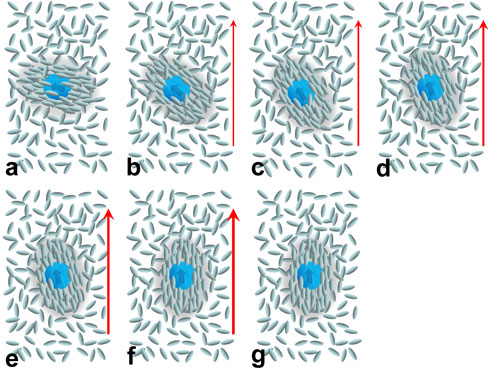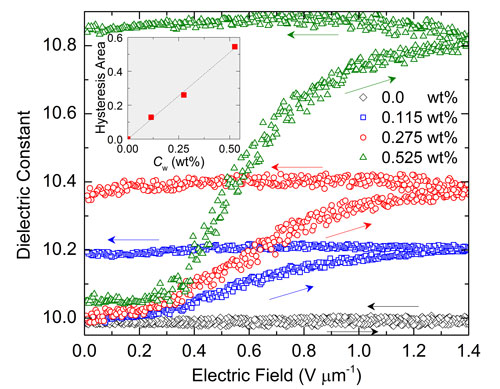| Posted: Feb 19, 2014 | |
Ferroelectric nanoparticle-doped liquid crystal - a nonvolatile multi-stable memory function |
|
| (Nanowerk Spotlight) Bi-stability is widely used in digital electronics devices to store binary data. It is the essential characteristic of the flip-flop, a circuit widely used in latches and some types of semiconductor memory. However, it is possible to store more data at the nanoscale with multi-stable memory functions. | |
| Reporting his findings in the February 18, 2014 online edition of Physical Review E ("Soft memory in a ferroelectric nanoparticle-doped liquid crystal"), Rajratan Basu, an Assistant Professor in the Department of Physics at the United States Naval Academy, has developed a multi-stable nonvolatile soft memory function by doping ferroelectric nanoparticles into liquid crystal (LC) matrices. | |
| This is an electromechanical memory which functions at the nanoscale. | |
| Liquid crystals exhibit a phase of matter that has properties between those of a conventional liquid and those of a solid crystal. This means that LCs can flow like a liquid, and at the same time the anisotropic LC-molecules maintain a long range crystalline order. | |
| In the nematic LC phase, the molecules are oriented in parallel, maintaining a long-range orientational order, but not arranged in well-defined planes. When the LC is heated up into the isotropic phase, the LC molecules lose their orientational order. | |
| BaTiO3 ferroelectric nanoparticles (FNPs), with a radius of 25 nm, possess a high spontaneous permanent polarization, resulting in a strong electric field, in the order of 1010 V m-1, close to their surfaces. | |
| "When a low concentration of FNPs is doped in the LC, the high field close to the FNPs can align individual LC molecules over a distance of 50 nm surrounding the particles, forming pseudo-nematic domains," Basu explains to Nanowerk. "In the nematic phase, these short-range domains align with the global nematic director to reduce the free energy of the system. However, in the isotropic phase, when the global nematic order is absent, the FNP-induced short-range orders become more prominent." | |
 |
|
| Figure 1: A schematic representation of the presence of a BaTiO3 FNP-induce pseudo-nematic domain in the isotropic phase. The sphere represents the FNP, the ellipsoids represent LC molecules, and the shaded area represents the domain. (a) No electric field; (b) the electric field is turned ON; (c), (d), (e), (f) the pseudo-nematic domain’s reorientation process as the electric field gradually increases; (g) the electric field is turned OFF and the domain stay oriented. (Image: Dr. Basu, United States Naval Academy) | |
| There is no long-range elastic interaction in the isotopic phase of a pure LC due to the absence of the long-range orientational order. In the presence of FNPs in the isotropic phase, the pseudo-nematic domains act as isolated anisotropic domains, responding to an external electric field. These domains can reorient along the direction of the external field, but when the field is turned off, the FNP-induced pseudo-nematic domains never come back to the original state due to the absence of any long-range elastic interaction. | |
| In other words, when the field is off, there is no restoring force to mechanically torque these domains back into the original orientation in the isotropic phase and the domains stay oriented, as schematically shown in Fig 1 above. | |
| This is the essence of a nonvolatile nano-electromechanical memory effect, as the electric field mechanically rotates the domains at the nanoscale. Also, in a thin LC cell (20 µm) the backflow of the LC is negligible, which increases the viscosity helping the domains stay oriented. | |
 |
|
| Figure 2: Dielectric hysteresis for pure 5CB LC and 5CB LC+BaTiO3 for three different concentrations listed in the legend. Note that the pure LC (0.0 wt%) does not show any memory effect. The arrows show the field-cycle direction. Inset: Hysteresis area (V µm-1) as a function of BaTiO3 concentration in 5CB LC. (Image: Dr. Basu, United States Naval Academy) | |
| Basu notes that the domain-reorientation is a continuous reorientation process when the external field gradually increases. "If the field is turned off at any intermediate stage, the domains stay locked into that particular oriented-state, showing an intermediate memory effect," he says. "Therefore, unlike bi-stable electronic memory devices, this nonvolatile nano-electromechanical memory is a multi-stable memory function." | |
| Figure 2 above shows the dielectric hysteresis of the memory effect for different FNP concentrations. | |
| This work was supported by the Office of Naval Research under Award No. N001613WX20992 and the investment grant at the US Naval Academy. | |
 By
Michael
Berger
– Michael is author of three books by the Royal Society of Chemistry:
Nano-Society: Pushing the Boundaries of Technology,
Nanotechnology: The Future is Tiny, and
Nanoengineering: The Skills and Tools Making Technology Invisible
Copyright ©
Nanowerk LLC
By
Michael
Berger
– Michael is author of three books by the Royal Society of Chemistry:
Nano-Society: Pushing the Boundaries of Technology,
Nanotechnology: The Future is Tiny, and
Nanoengineering: The Skills and Tools Making Technology Invisible
Copyright ©
Nanowerk LLC
|
|
|
Become a Spotlight guest author! Join our large and growing group of guest contributors. Have you just published a scientific paper or have other exciting developments to share with the nanotechnology community? Here is how to publish on nanowerk.com. |
|
